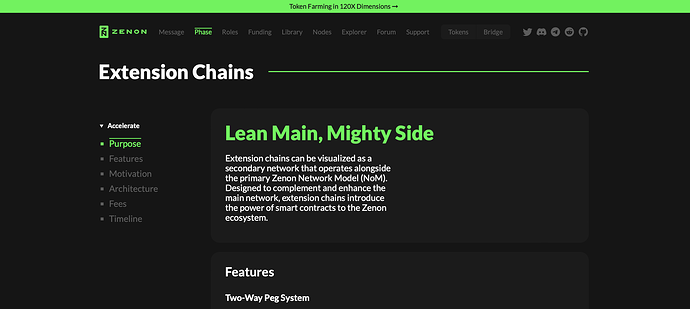you’re an uncultured fatty
let’s just name it “extension chain” to amplify the “if autism was a blockchain” theme we have going
I would like to discuss the extension chains fee structure further: why is it a bad choice to make it feeless and if there’s fee wouldn’t it be interesting to make dApps pay or decide of a custom fee structure? I came across an interesting article about how Chromia is doing it : The Power of Customizable Fee Structures
Where did you read this? The extension chain won’t be feeless.
How?
Customizable fees can be a future milestone.
Sorry, excuse my English. I meant why not making it feeless.
As for the fee structure I refered to dApps being able to control it but not only the distribution. Ad you can read on the Chromia article and docs a dApp can decide there to handle the fee aka buying upfront the necessary tokens to run the product and pay for users + can charge fee anywhere they want while letting certain kinds of tx free from fee if they wish to do so. I don’t know how the Chromia network allows this at a deeper level but it could be attracting for users depending on the product. They are focused on gaming for now with one good game already available on Steam (not the usual crypto crap).
I also think I missed the why an extension chain needs fee, hence my initial question followed by an exemple of a different way to handle the fee in allowing different business perspectives and models to unfold.
EDIT: with the structure suggested above we could for exemple imagine pillars or other entities sponsoring dApps with QSR, ZNN or plasma, opening a brand new market and models for business fully onchain.
Is it possible that it will just end up being the decision of the deployer how to incorporate fees into any future extension chain?
The bridge already appears to get a succesful effort from pillars to run the orchestrators so with the right dApps/business model any extension chain could be profitable enough, by means outside of tx fees, to the point of easily being able to incentivize pillars to participate as validators on the chain. In principle it does push things a little further away from decentralization and security of the L1, but the might be worth the tradeoff for the benefits of feeless txs.
Seems like it will depend on the application. Do these extension chain have this kind of flexibility?
Incentivize validators to spin up nodes, builders to develop smart contracts and passively every NoM user by burning ZNN.
They only need xZNN to run on the ext-chain.
Another interesting topic is revenue sharing: dApp contract deployers/businesses sharing fee revenue with their users.
Yes.
It is up to the ext-chain deployer to setup the fee structure.
Making good progress with the ext-chain.
Still need to test the EVM smart contracts, but we’re getting closer and closer to launching an initial devnet.
#bullish
As you can see activity decreases with each L2.
How can our Extension chain stand out? We don’t even have a significant volume in our base chain and bridge.
We don’t want our extension chain to be just another one in the long list or DOA , do we?
Incrementally superior blockchains cannot compete with network effects of earlier, technically inferior ones.
To outpace it and break rheough competitor’s network effects, a new DLT must provide a revolutionary advantage.
See Google vs Bing vs GPT
All the other L2 are eth only related though. Plus, we’re in a giga bear market. What ultimately matters is the NoM. The L2 is a way to allow people to build easier and onboard faster. Not the core of Zenon.
I just got off a call with someone who literally asked for this. They key is that the EVM is running on Zenon infrastructure and that it brings more awareness to the long term of the NoM. There are life forms out there who can appreciate what we’re building.
- Since the NEAR-to-Ethereum Relayer only sends NEAR block headers to the Ethereum LiteNode every 16 hours, there’s a 16 hour delay between steps one and two when moving tokens in that direction. (Remember, this is because Ethereum gas fees make it prohibitively expensive for the Relayer to update the LiteNode on every block.) There are a number of approaches that would allow us to reduce this delay, and the team is actively working on that.
We don’t have this issue on NoM. Transaction are feeless as long as there is enough PoW generated for the transaction containing the block headers.
Frequency of NEAR Blocks Transfer: NEAR blocks’ headers are sent to Ethereum only once every 4 hours due to the expensive gas fees on the Ethereum network. This can result in a total transfer time of up to 8 hours, including the block transfer and a challenge period.
PS: Aurora is Near’s EVM chain.
Added extension chains to the upcoming refactored release of zenon.org ![]()
The first EVM compatible extension chain is now live ![]()
![]()
How to connect an EVM compatible wallet to the ext-chain:
- Install Metamask
- Create a new wallet
- Go to
Settings→Networks
- Network name:
XZNN - New RPC URL: https://ext-testnet.zenon.community
- ChainID: 73405
- Symbol:
xZNN
- Post your address below and request
xZNNfor testing. Maximum amount is10000 xZNNper user.
0xa9720C65C9a5B441a9093115beBC6545cfd12723 will take one of these 10k xZNN plz ![]()
Done.
Received. Thankz
Woohoo!! Congratulations on the launch zir!
I would like to request 10k xZNN on this address: 0x3BB6aD1345f6996Fad3053691Da0Bd0f60D6150E
WAGMI ![]()

